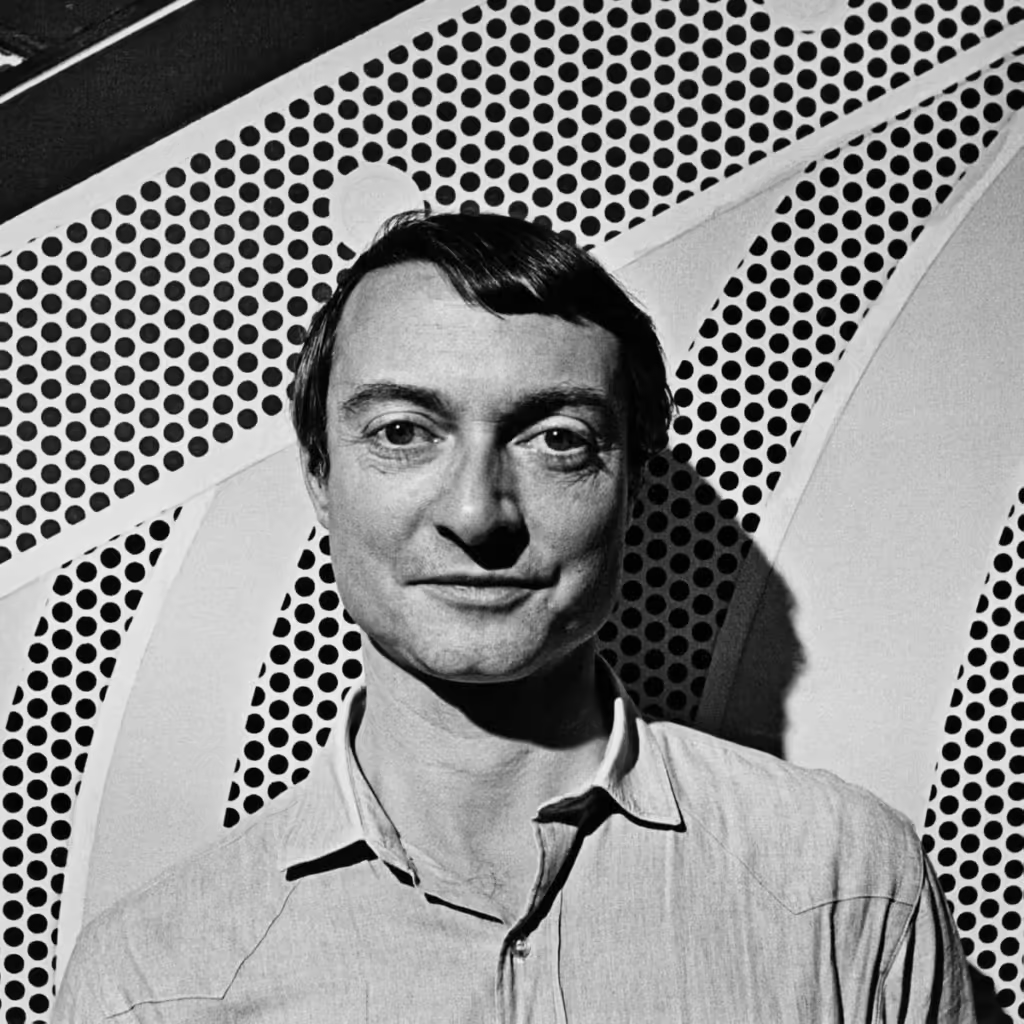
Table of Contents
Who Was Roy Lichtenstein?
In the 1960s, Roy Lichtenstein emerged as a pivotal figure in the Pop Art movement. His work, characterized by bright colors and graphic styles, drew inspiration from advertisements and comic strips, parodying elements of American popular culture and critiquing the art world itself.
Early Years
Roy Fox Lichtenstein was born on October 27, 1923, in New York City to Milton Lichtenstein, a successful real estate developer, and Beatrice Werner Lichtenstein. Growing up on Manhattan’s Upper West Side, Lichtenstein developed a passion for both science and comic books. He began his formal art education at the Parsons School of Design in 1937, where he took watercolor classes. In 1940, he furthered his studies at the Art Students League under the tutelage of American realist painter Reginald Marsh.
After graduating from the Franklin School for Boys in 1940, Lichtenstein enrolled at The Ohio State University. However, his academic pursuits were interrupted in 1943 when he was drafted into the U.S. Army and deployed to Europe during World War II. Following his military service, he returned to Ohio State in 1946 to complete both his undergraduate and master’s degrees in fine arts. Lichtenstein briefly taught at the university before moving to Cleveland, where he worked as a window-display designer for a department store, an industrial designer, and a commercial art instructor.
Commercial Success and Pop Art
In the late 1940s, Lichtenstein began exhibiting his art in galleries across the United States, including venues in Cleveland and New York City. During the 1950s, he frequently drew inspiration from mythology, American history, and folklore, employing styles that paid homage to art from the 18th century through modernism.
In the early 1960s, while teaching at Rutgers University, Lichtenstein began experimenting with new subjects and techniques. His work served as both a commentary on American popular culture and a response to the prevailing success of Abstract Expressionism, exemplified by artists like Jackson Pollock and Willem de Kooning. Unlike his contemporaries, who often painted abstract and emotionally charged canvases, Lichtenstein appropriated imagery directly from comic books and advertisements. He eschewed a personal touch in favor of a mechanical aesthetic, employing a stencil process that mimicked the commercial printing techniques of his sources.
One of his most iconic works from this period is “Whaam!,” created in 1963, which was inspired by a comic book panel from a 1962 issue of DC Comics’ All-American Men of War. His 1960s oeuvre also featured beloved cartoon characters like Mickey Mouse and Donald Duck, as well as advertisements for various consumer products. Notably, he produced a large-scale mural of a laughing young woman, adapted from a comic book image, for the New York State Pavilion at the 1964 World’s Fair in New York City.
Lichtenstein became renowned for his deadpan humor and subtly subversive approach, crafting a distinctive body of work from mass-produced images. By the mid-1960s, he had gained national recognition as a leading figure in the Pop Art movement alongside contemporaries such as Andy Warhol, James Rosenquist, and Claes Oldenburg. His art sparked discussions regarding originality, consumerism, and the tenuous boundary between fine art and entertainment, cementing his legacy in the art world.
Later Career
By the late 1960s, Roy Lichtenstein had transitioned away from his initial comic book influences. In the 1970s, he shifted his focus to creating paintings that drew inspiration from early 20th-century masters such as Pablo Picasso, Henri Matisse, Fernand Léger, and Salvador Dalí. During the 1980s and 1990s, Lichtenstein expanded his repertoire to include representations of modern house interiors, brushstrokes, and mirror reflections, all rendered in his distinctive, cartoon-like style. Additionally, he began exploring the medium of sculpture.
In the 1980s, Lichtenstein undertook several significant large-scale commissions, including a 25-foot-high sculpture titled “Brushstrokes in Flight,” installed at the Port Columbus International Airport in Columbus, Ohio, and a striking five-story mural for the lobby of the Equitable Tower in New York City.
Lichtenstein remained dedicated to his artistic practice until the end of his life, often spending a minimum of 10 hours each day in his studio. His work gained recognition in major museum collections worldwide, and he received numerous honorary degrees and awards, including the National Medal of Arts in 1995.
Death
Lichtenstein passed away on September 29, 1997, due to complications from pneumonia at New York University Medical Center in Manhattan.
Personal Life
Lichtenstein was married twice. His first marriage was to Isabel in 1949, with whom he had two sons, David and Mitchell; they divorced in 1967. He later married Dorothy Herzka in 1968.
